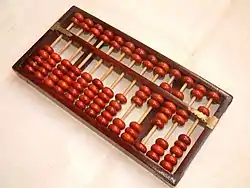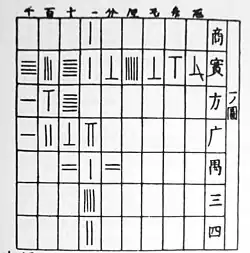算盤
Chinese
regard as; to figure; to calculate regard as; to figure; to calculate; to compute | dish; tray; to build dish; tray; to build; to check; to examine; to transfer; (a measure word used for dishes of food or coils of wire); to coil | ||
|---|---|---|---|
| trad. (算盤) | 算 | 盤 | |
| simp. (算盘) | 算 | 盘 | |
| alternative forms | 筭盤/筭盘 | ||
| anagram | 盤算/盘算 | ||
Pronunciation

Noun
算盤
- (mathematics) abacus
- (figuratively) plan; plan of action; master plan
Synonyms
- (abacus): 算子 (suànzǐ)
| Variety | Location | Words edit |
|---|---|---|
| Formal (Written Standard Chinese) | 算盤 | |
| Mandarin | Beijing | 算盤 |
| Taiwan | 算盤 | |
| Ulanhot | 算盤 | |
| Tongliao | 算盤 | |
| Chifeng | 算盤 | |
| Bayanhot | 算盤 | |
| Hulunbuir (Hailar) | 算盤 | |
| Harbin | 算盤兒 | |
| Shenyang | 算盤 | |
| Yantai (Muping) | 算盤子 | |
| Jinan | 算盤 | |
| Luoyang | 算盤 | |
| Wanrong | 盤子, 算盤 | |
| Zhengzhou | 算盤 | |
| Xi'an | 算盤 | |
| Yinchuan | 算盤 | |
| Lanzhou | 算盤 | |
| Xining | 算盤 | |
| Ürümqi | 算盤 | |
| Wuhan | 算盤 | |
| Chengdu | 算盤 | |
| Guiyang | 算盤 | |
| Kunming | 算盤 | |
| Guilin | 算盤 | |
| Liuzhou | 算盤 | |
| Xuzhou | 算盤 | |
| Yangzhou | 算盤 | |
| Hefei | 算盤 | |
| Singapore | 算盤 | |
| Cantonese | Guangzhou | 算盤 |
| Hong Kong | 算盤 | |
| Hong Kong (San Tin Weitou) | 算盤 | |
| Foshan | 算盤 | |
| Foshan (Shunde) | 算盤 | |
| Zhongshan (Shiqi) | 算盤 | |
| Zhuhai (Doumen, Shangheng Tanka) | 算盤 | |
| Taishan | 算盤 | |
| Kaiping (Chikan) | 算盤 | |
| Dongguan | 算盤 | |
| Shaoguan | 算盤 | |
| Yunfu | 算盤 | |
| Yangjiang | 算盤 | |
| Xinyi | 算盤 | |
| Lianjiang | 算盤 | |
| Nanning | 算盤 | |
| Wuzhou | 算盤 | |
| Yulin | 算盤 | |
| Hepu (Lianzhou) | 算盤 | |
| Beihai | 算盤 | |
| Beihai (Qiaogang - Cô Tô) | 算盤 | |
| Beihai (Qiaogang - Cát Bà) | 算盤 | |
| Fangchenggang (Fangcheng) | 算盤 | |
| Kuala Lumpur (Guangfu) | 算盤 | |
| Ho Chi Minh City (Guangfu) | 算盤 | |
| Móng Cái | 算盤 | |
| Gan | Nanchang | 算盤 |
| Lichuan | 算盤 | |
| Pingxiang | 算盤 | |
| Hakka | Meixian | 算盤 |
| Yudu | 算盤子 | |
| Miaoli (N. Sixian) | 算盤 | |
| Pingtung (Neipu; S. Sixian) | 算盤 | |
| Hsinchu County (Zhudong; Hailu) | 算盤 | |
| Taichung (Dongshi; Dabu) | 算盤 | |
| Hsinchu County (Qionglin; Raoping) | 算盤 | |
| Yunlin (Lunbei; Zhao'an) | 算盤 | |
| Hong Kong | 算盤 | |
| Luchuan (Daqiao) | 算盤 | |
| Senai (Huiyang) | 算盤 | |
| Singkawang | 算盤 | |
| Huizhou | Jixi | 算盤 |
| Jin | Taiyuan | 算盤 |
| Xinzhou | 算盤子 | |
| Taibus (Baochang) | 算盤 | |
| Linhe | 算盤 | |
| Jining | 算盤 | |
| Hohhot | 算盤子 | |
| Baotou | 算盤 | |
| Dongsheng | 算盤 | |
| Haibowan | 算盤兒 | |
| Min Bei | Jian'ou | 算盤 |
| Min Dong | Fuzhou | 算盤 |
| Fuqing | 算盤 | |
| Min Nan | Xiamen | 算盤 |
| Quanzhou | 算盤 | |
| Zhangzhou | 算盤 | |
| Taipei | 算盤 | |
| New Taipei (Sanxia) | 算盤 | |
| Kaohsiung | 算盤 | |
| Yilan | 算盤 | |
| Changhua (Lukang) | 算盤 | |
| Taichung | 算盤 | |
| Tainan | 算盤 | |
| Hsinchu | 算盤 | |
| Kinmen | 算盤 | |
| Penghu (Magong) | 算盤 | |
| Penang (Hokkien) | 算盤 | |
| Manila (Hokkien) | 算盤 | |
| Pingnan (Shangdu) | 算盤 | |
| Chaozhou | 算盤 | |
| Haifeng | 算盤 | |
| Johor Bahru (Teochew) | 算盤 | |
| Leizhou | 數盤 | |
| Haikou | 算盤 | |
| Zhongshan Min | Sanxiang | 算盤 |
| Southern Pinghua | Nanning (Tingzi) | 算盤 |
| Northern Pinghua | Guilin (Dahe) | 算盤 |
| Wu | Shanghai | 算盤 |
| Shanghai (Chongming) | 算盤 | |
| Suzhou | 算盤 | |
| Danyang | 算盤 | |
| Hangzhou | 算盤 | |
| Ningbo | 算盤 | |
| Wenzhou | 算盤 | |
| Jinhua | 算盤 | |
| Xiang | Changsha | 算盤, 算盤子 |
| Loudi | 算划子 | |
| Shuangfeng | 算盤子 | |
| Quanzhou | 算盤 | |
Derived terms
|
|
Descendants
- → Bouyei: suansbaanz, suansbeanz
- → English: suanpan
- → Hlai: duixbhuas
- → Japanese: 算盤 (soroban)
- → Malay: sempoa, sepua, cepua, suipoa
- → Mongolian: ᠰᠤᠸᠠᠨᠫᠠᠨ (suwanpan) / сампин (sampin)
- → Zhuang: suenqbuenz
Japanese

Etymology 1
| Kanji in this term | |
|---|---|
| 算 | 盤 |
| そろ Grade: 2 | ばん Grade: S |
| irregular | goon |
| Alternative spellings |
|---|
| 十露盤 曾呂盤 珠盤 揃盤 三羅盤 (possibly read as saraban) |
Japanese sources consistently describe the abacus itself as being imported to Japan from China some time during the Muromachi period (1336–1573), although there is some disagreement as to whether this happened early in the period,[1] or late.[2][3][4][5]
First attested with the reading soroban in the 1595 trilingual Latin-Portuguese-Japanese dictionary Dictionarium Latino Lusitanicum, Ac Iaponicum, also 羅葡日対訳辞書 (Ra-Ho-Nichi Taiyaku Jisho, “Latin-Portuguese-Japanese Translation Dictionary”) based on work originally by Ambrogio Calepino,[6] corroborated in the Nippo Jisho of 1603.[2][7]
Japanese sources generally describe the soroban reading as a shift or corruption from the reading swanpan, the 唐音 (tōon, literally "Tang sound", referring to the Chinese-derived kanji readings that were borrowed into Japanese during the Tang dynasty or later) for the kanji spelling.[2][5] However, this is problematic on phonological grounds:
- There is no known phonological process whereby swan would become soro in Japanese.
- Middle Chinese swan consistently became Japanese san in all other known instances of the Chinese reading swan for any kanji character.
- The character 算 appearing as the first character in 算盤 (soroban) is also read as san, and san is similarly listed as a synonym for soroban in the 1595 dictionary entry.[6]
An alternative, albeit speculative, explanation is that this soro- is some other morpheme unrelated to the Chinese. If so, this might be native root soro-, as seen in adverb そろそろ (sorosoro, “quietly and calmly”), そろり (sorori) and そろっと (sorotto, “quietly and smoothly; slidingly, glidingly”), verb 揃う (sorou, “to be in alignment; to be in order; to match, to go together”).
Notably, this term appears historically with the alternative kanji spelling 三羅盤. Given the expected Japanese readings of these characters, this may have been read as saraban. Root sara- -- and also root suru- -- also appear in various terms related to senses of smooth, gliding, sliding.
Pronunciation
- (Tokyo) そろばん [sòróbáń] (Heiban – [0])[5][8][9]
- IPA(key): [so̞ɾo̞bã̠ɴ]
Noun
算盤 • (soroban)
- [from 1595] (mathematics) an abacus
- 手を算盤として六進法で計算する
- te o soroban to shite roku-shinhō de keisan suru
- calculate in base-6 using one's hands as an abacus
- 手を算盤として六進法で計算する
Derived terms
- 算盤占い (soroban'uranai)
- 算盤が合う (soroban ga au)
- 算盤が持てない (soroban ga motenai)
- 算盤勘定 (sorobankanjō)
- 算盤木 (sorobangi)
- 算盤桟手 (sorobansade)
- 算盤絞り (sorobanshibori)
- 算盤尽く (sorobanzuku)
- 算盤責め (sorobanzeme)
- 算盤高い (sorobandakai)
- 算盤玉 (sorobandama)
- 算盤の玉はずれ (soroban no tama wa zure)
- 算盤を置く (soroban o oku)
- 算盤を弾く (soroban o hajiku)
- 算盤を枕にする (soroban o makura ni suru)
Etymology 2
| Kanji in this term | |
|---|---|
| 算 | 盤 |
| さん Grade: 2 | ばん Grade: S |
| on’yomi | goon |

Ultimately from Middle Chinese 算盤 (MC suɑnX buɑn, “abacus”, literally “calculation + board, grid”). Compare modern Min Nan reading seng3 buan5, Mandarin suànpán.
Japanese sources consistently describe the abacus itself as being imported to Japan from China some time during the Muromachi period (1336–1573), although there is some disagreement as to whether this happened early in the period,[1] or late.[2][3][4][5]
First attested with the reading sanban to a text from 1688.[2]
Pronunciation
- (Tokyo) さんばん [sàńbáń] (Heiban – [0])[5]
- IPA(key): [sã̠mbã̠ɴ]
Noun
算盤 • (sanban) ←さんばん (sanban)?
- [from 1688] (mathematics) a kind of grid used in 和算 (wasan, “traditional Japanese mathematics”) to calculate higher-order functions
- [from 1717] (mathematics) an abacus
References
- “そろばん”, in ブリタニカ国際大百科事典 小項目事典 (Buritanika Kokusai Dai Hyakka Jiten: Shō Kōmoku Jiten, “Encyclopædia Britannica International: Micropædia”) (in Japanese), Tōkyō: Britannica Japan Co., Ltd., 2014
- 1988, 国語大辞典(新装版) (Kokugo Dai Jiten, Revised Edition) (in Japanese), Tōkyō: Shogakukan
- 1995, 大辞泉 (Daijisen) (in Japanese), Tōkyō: Shogakukan, →ISBN
- “算盤”, in 日本大百科全書:ニッポニカ (Nippon Dai Hyakka Zensho: Nipponica, “Encyclopedia Nipponica”) (in Japanese), Tōkyō: Shogakukan, 1984
- 2006, 大辞林 (Daijirin), Third Edition (in Japanese), Tōkyō: Sanseidō, →ISBN
- 1595, Dictionarium Latino Lusitanicum, Ac Iaponicum (in Latin, Portuguese, and Japanese), 1979 reprint, Tōkyō: Bensei Publishing, text visible online in the Abáculus entry here
- 1603, 日葡辞書: パリ本 / Vocabulario da Lingoa de Iapam (Nippo Jisho: Paris edition / Vocabulary of the Language of Japan) (in Japanese and Portuguese), 1976 reprint, Tōkyō: Bensei Publishing, text visible online here, two entries above the highlighted term
- 1998, NHK日本語発音アクセント辞典 (NHK Japanese Pronunciation Accent Dictionary) (in Japanese), Tōkyō: NHK, →ISBN
- 1997, 新明解国語辞典 (Shin Meikai Kokugo Jiten), Fifth Edition (in Japanese), Tōkyō: Sanseidō, →ISBN